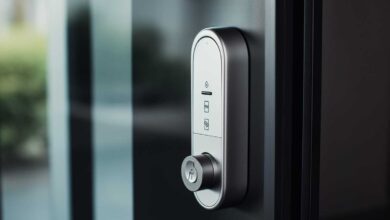Understanding Keyless Entry Systems
KEY TAKEAWAYS
In our fast-paced, technology-driven world, convenience and security are paramount. One such innovation that effectively combines these two aspects is the keyless entry system. This system, commonly used in vehicles and buildings, allows access without a traditional physical key, offering both convenience and enhanced security.
This comprehensive guide delves into the intricacies of keyless entry systems, shedding light on their benefits, potential drawbacks, and the technology that powers them.
What Is A Keyless Entry System?
A keyless entry system, often referred to as remote keyless entry (RKE) or remote central locking, is an electronic lock mechanism that grants access to a building or vehicle without the use of a traditional mechanical key. Instead, it utilizes an electronic remote control as a key, which communicates with the lock through radio signals. The most common form of keyless entry system is found in modern vehicles, where a key fob or a smart card can be used to unlock the doors and even start the engine without inserting a physical key.
The basic principle behind keyless entry is the communication between the key fob and the vehicle or door. When the fob is within a certain range, it searches for the radio signals emitted from the car or door. Once the fob recognizes these signals, it sends a unique code back to the vehicle or door, allowing it to unlock. This process is almost instantaneous, providing users with quick and convenient access.
Benefits Of Keyless Entry Systems
-
Enhanced Security: One of the primary benefits of keyless entry systems is the heightened level of security they offer. Traditional keys can be easily duplicated, lost, or stolen, but keyless systems are harder to tamper with. Many modern systems also come with encrypted communication, ensuring that the authentication credentials are secure.
-
Convenience: Gone are the days of fumbling around with a set of keys. With keyless entry, access is quick and hassle-free. Whether it’s unlocking your car or your home, the process is streamlined and efficient.
-
Remote Access: Many keyless entry systems can be controlled remotely via smartphone apps. This feature allows users to lock or unlock their doors from a distance, which can be especially useful in situations where you’ve forgotten to lock up or need to grant access to someone while you’re away.
-
Cost Savings: Over time, keyless entry systems can prove to be more cost-effective. There’s no need to constantly replace lost keys or change locks. Additionally, the potential savings from enhanced security—such as preventing break-ins—can be substantial.
-
No More Lost Keys: One of the most common issues with traditional keys is that they can be easily lost or misplaced. With keyless entry, this problem is eliminated. There’s no need to hide an emergency key or worry about getting locked out.
-
Access Control: For businesses, keyless entry systems offer superior access control. They can track all entry activity in real-time, providing a detailed record of who accessed a particular area and when. This can be crucial for security audits and ensuring only authorized personnel have access to sensitive areas.
Types Of Keyless Entry Systems
Keyless entry systems have become increasingly popular due to their convenience and enhanced security features. There are several types of keyless entry systems, which include remote keyless entry, biometric authentication, key card access systems, and more.
Remote Keyless Entry Systems
Remote Keyless Entry Systems, often abbreviated as RKE, are electronic locking systems that allow users to unlock or lock their vehicle without the need to physically use a key. These systems function using a handheld remote, commonly referred to as a key fob. When the button on the fob is pressed, it sends a signal to the receiver inside the vehicle, typically operating at a frequency of 315MHz in the U.S. This signal instructs the vehicle to lock or unlock its doors. Modern RKE systems also often include features like remote engine start and trunk release.
Biometric Authentication
Biometric authentication systems use unique biological characteristics of an individual to grant access. These characteristics can include fingerprints, facial recognition, iris scans, and voice prints. Biometric systems offer a high level of security as they rely on unique physical attributes that are difficult to replicate. For instance:
-
Fingerprint Recognition: Scans and matches the unique patterns of a user’s fingerprint.
-
Facial Recognition: Uses cameras and software to match the facial features of a user to stored data.
-
Iris Scanning: Analyzes the unique patterns in the colored part of an eye.
These systems are becoming increasingly popular in high-security areas and modern residential complexes due to their enhanced security features and convenience.
Key Card Access System
Key card access systems are electronic locks that use a card embedded with a magnetic strip or RFID chip as a key. Users swipe or tap the card against a reader to gain access. These systems are commonly found in hotels, offices, and other commercial buildings. The primary advantages of key card systems include:
-
Enhanced Security: The system can be programmed to allow access only during certain times or to specific areas.
-
Audit Trails: The system can track when and where each card was used, providing a record of all entries and exits.
-
Easy Management: Lost or stolen cards can be easily deactivated, and new cards can be issued without changing the locks.
Advanced Systems
The landscape of vehicle security and building access is continuously evolving, with the introduction of more advanced keyless entry systems. These systems often integrate multiple technologies to provide enhanced security and convenience. For instance:
-
Smartphone Integration: Some systems allow users to unlock doors or start their vehicles using a smartphone app, eliminating the need for a physical key or fob altogether.
-
Proximity Sensors: Advanced systems can automatically detect when an authorized user is approaching and unlock the doors without any action from the user.
-
Touchless Authentication: Some systems use advanced sensors to detect gestures or other touchless cues to grant access.
These advanced systems often combine the features of traditional keyless entry methods with newer technologies, offering users a seamless and secure experience.
How Do Keyless Entry Systems Work?
Keyless entry systems work by using radio waves to communicate with your vehicle. However, newer versions go beyond this. Here we explore the workings of these systems in more detail:
Radio Signals And Remote Control
Keyless entry systems operate primarily through the use of radio waves, a type of electromagnetic radiation. These systems involve a transmitter, typically found in a key fob or remote, and a receiver located inside the vehicle or access point. When a button on the key fob is pressed, it sends a coded radio signal to the receiver. The receiver captures this RF (Radio Frequency) signal, processes it, and then sends the data to the central processing unit (CPU) of the vehicle or access system. This communication instructs the vehicle or door to lock or unlock based on the signal received. The range of these signals is typically limited to ensure security, often working within a range of 5-20 meters.
Modern Vehicle Technology And Mobile Device Accessibility
With the rapid advancement of technology, modern vehicles are now equipped with more sophisticated keyless entry features that go beyond traditional radio signals. The global automotive keyless entry system market witnessed significant growth, escalating from $1.4 billion in 2022 to $1.57 billion in 2023. This represents a notable compound annual growth rate (CAGR) of 12.1%. Here’s a look at some of the latest developments:
-
Smartphone Integration: Many modern vehicles now offer the ability to control keyless entry systems via smartphone apps. This integration allows users to lock, unlock, and even start their vehicles using their mobile devices. The communication between the vehicle and the smartphone is often secured using advanced encryption algorithms to ensure safety.
-
GPS Tracking: Some advanced keyless entry systems come with integrated GPS tracking. This feature allows users to locate their vehicles in real-time, adding an extra layer of security and convenience.
-
Bluetooth Connectivity: Bluetooth technology has also found its way into keyless entry systems. Through Bluetooth pairing, vehicles can establish connections with mobile devices, enabling touchless unlocking when the paired device is in proximity.
-
NFC (Near Field Communication): NFC is another technology being incorporated into keyless entry systems. NFC allows for short-range communication between the vehicle and a device, such as a smartphone or a specialized key card. When the device is in close proximity to the vehicle, it can send a signal to unlock the doors or even start the engine.
-
Cloud-Based Systems: Some modern keyless entry solutions are cloud-based, allowing for remote access and control from anywhere in the world. This is especially useful for fleet management or for individuals who want to grant access to their vehicles remotely.
Advantages Of Keyless Entry Systems
Keyless entry systems have become increasingly popular in recent years, both for vehicles and buildings. Their rise in popularity can be attributed to the numerous advantages they offer over traditional key-based systems. Here are some of the primary benefits of keyless entry systems:
-
Enhanced Security: Keyless entry systems often use encrypted communication to authenticate credentials, making them harder to tamper with compared to traditional keys. The absence of a physical key eliminates the risk of lock picking, and the system can be easily reprogrammed if security is compromised.
-
Convenience: One of the most significant advantages of keyless entry is the convenience it offers. Users no longer need to fumble around with a set of keys. With just a touch or a code, access is granted.
-
No More Lost Keys: Traditional keys can be easily lost, misplaced, or stolen. With keyless entry, this problem is virtually eliminated. There’s no need to hide an emergency key or worry about getting locked out.
-
Remote Access: Many keyless entry systems can be controlled remotely, often via smartphone apps. This feature allows users to lock or unlock their doors from a distance, which can be especially useful in situations where you’ve forgotten to lock up or need to grant access to someone while you’re away.
-
Access Control: Keyless entry systems offer superior access control, especially for businesses. They can track all entry activity in real-time, providing a detailed record of who accessed a particular area and when. This can be crucial for security audits and ensuring only authorized personnel have access to sensitive areas.
-
Cost Savings: Over time, keyless entry systems can prove to be more cost-effective. There’s no need to constantly replace lost keys or change locks. Additionally, the potential savings from enhanced security—such as preventing break-ins—can be substantial.
-
Customizable Access: Keyless systems allow for customizable access levels. For instance, certain employees or family members can be granted access only during specific times or to particular areas of a building.
-
Less Waste: Traditional keys can contribute to metal waste when they’re discarded. With keyless systems, there’s a reduction in the number of physical keys produced and discarded, leading to a more environmentally friendly solution.
-
Modern Aesthetics: Many keyless entry systems come with sleek and modern designs, adding a touch of sophistication to doors and entryways.
-
Integration With Other Systems: Keyless entry systems can often be integrated with other home or business systems, such as alarm systems, surveillance cameras, or smart home devices, providing a comprehensive security solution.
Disadvantages Of Keyless Entry Systems
While keyless entry systems offer numerous advantages, they are not without their drawbacks. Here are some of the potential disadvantages of keyless entry systems:
-
Memory Challenges: For systems that require a code or PIN, users must remember the correct sequence to gain access. For those who have trouble remembering codes, this can be a significant inconvenience.
-
Power Failure: Since most modern keyless entry systems are electronic, they rely on a power source to function. In the event of a power failure, there’s a risk that the system may not operate correctly, potentially locking users out.
-
Potential For Hacking: Like any electronic system, keyless entry systems can be vulnerable to hacking. Skilled hackers might exploit vulnerabilities in the system to gain unauthorized access.
-
Higher Costs: Keyless entry systems, especially advanced ones, can be more expensive to install and maintain than traditional lock-and-key systems.
-
Battery Dependency: Many keyless systems, especially those in vehicles, rely on batteries in the key fob or remote. If the battery dies, the system may not function, leading to potential lockouts.
-
Technical Malfunctions: As with any technology, there’s a chance of technical malfunctions or glitches that can affect the system’s performance.
-
Security Concerns: While keyless entry systems offer enhanced security in many ways, they are not foolproof. For instance, there have been reports of relay attacks on vehicle keyless systems, where thieves can amplify the signal from a key fob inside a house to unlock a car parked outside.
-
Limited Durability: Some keyless entry systems, especially those with touchscreens or keypads, might wear out over time, especially if exposed to harsh weather conditions.
-
Complexity: For those not tech-savvy, setting up and managing a keyless entry system can be more complex than simply using a traditional key.
-
False Sense Of Security: Because of the advanced nature of keyless systems, some users might develop a false sense of security, thinking they are impervious to break-ins or unauthorized access.
Getting A Keyless Entry System
Keyless entry systems represent a blend of innovation and practicality, offering users an enhanced level of security and convenience. While they come with their set of challenges, the advantages often outweigh the drawbacks, making them a popular choice for many. As technology continues to evolve, it’s clear that the future of access control lies in these advanced systems, promising even more features and benefits in the years to come. Whether you’re considering installing one for personal use or for your business, understanding their workings, advantages, and potential pitfalls can help you make an informed decision.
Learn more about ways to secure your home by checking out our detailed guide on —. Visit Security Forward and browse through the available resources to learn more.





